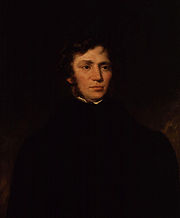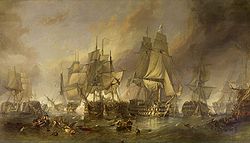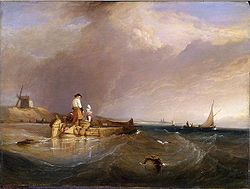
William Clarkson Stanfield
Encyclopedia

Painting
Painting is the practice of applying paint, pigment, color or other medium to a surface . The application of the medium is commonly applied to the base with a brush but other objects can be used. In art, the term painting describes both the act and the result of the action. However, painting is...
; he is often though inaccurately called William Clarkson Stanfield.
Early life

Thomas Clarkson
Thomas Clarkson , was an English abolitionist, and a leading campaigner against the slave trade in the British Empire. He helped found The Society for Effecting the Abolition of the Slave Trade and helped achieve passage of the Slave Trade Act of 1807, which ended British trade in slaves...
, the slave trade abolitionist, whom his father knew, and this was the only forename he used, although there is reason to believe Frederick was a second one.
Stanfield probably inherited artistic talent from his mother, who is said to have been an artist but died in 1801. He was briefly apprenticed to a coach decorator in 1806, but left owing to the drunkenness of his master's wife and joined a South Shields
South Shields
South Shields is a coastal town in Tyne and Wear, England, located at the mouth of the River Tyne to Tyne Dock, and about downstream from Newcastle upon Tyne...
collier to become a sailor. In 1808 he was pressed
Impressment
Impressment, colloquially, "the Press", was the act of taking men into a navy by force and without notice. It was used by the Royal Navy, beginning in 1664 and during the 18th and early 19th centuries, in wartime, as a means of crewing warships, although legal sanction for the practice goes back to...
into the Royal Navy
Royal Navy
The Royal Navy is the naval warfare service branch of the British Armed Forces. Founded in the 16th century, it is the oldest service branch and is known as the Senior Service...
, serving in the guardship Namur at Sheerness
Sheerness
Sheerness is a town located beside the mouth of the River Medway on the northwest corner of the Isle of Sheppey in north Kent, England. With a population of 12,000 it is the largest town on the island....
. Discharged on health grounds in 1814, he then made a voyage to China in 1815 on the East Indiaman Warley
Warley (East Indiaman)
The Warley was a 1475-ton East Indiaman and one of the East India Company's larger and more famous vessels. She made nine voyages to the East between 1796 and 1816, most direct to China. In 1804 she participated in the Battle of Pulo Aura...
and returned with many sketches.
Scenery
In August 1816 Stanfield was engaged as a decorator and scene-painter at the Royalty Theatre in Wellclose Square, London. Along with David RobertsDavid Roberts (painter)
David Roberts RA was a Scottish painter. He is especially known for a prolific series of detailed lithograph prints of Egypt and the Near East that he produced during the 1840s from sketches he made during long tours of the region . These, and his large oil paintings of similar subjects, made him...
he was afterwards employed at the Coburg theatre, Lambeth
Lambeth
Lambeth is a district of south London, England, and part of the London Borough of Lambeth. It is situated southeast of Charing Cross.-Toponymy:...
, and in 1823 he became a resident scene-painter at the Drury Lane
Drury Lane
Drury Lane is a street on the eastern boundary of the Covent Garden area of London, running between Aldwych and High Holborn. The northern part is in the borough of Camden and the southern part in the City of Westminster....
theatre, where he rose rapidly to fame through the huge quantity of spectacular scenery which he produced for that house until 1834.
Stanfield abandoned scenery painting after Christmas 1834 — though he made exceptions for two personal friends. He designed scenery for the stage productions of William Charles Macready
William Charles Macready
-Life:He was born in London, and educated at Rugby.It was his intention to go up to Oxford, but in 1809 the embarrassed affairs of his father, the lessee of several provincial theatres, called him to share the responsibilities of theatrical management. On 7 June 1810 he made a successful first...
, and for the amateur theatricals of Charles Dickens
Charles Dickens
Charles John Huffam Dickens was an English novelist, generally considered the greatest of the Victorian period. Dickens enjoyed a wider popularity and fame than had any previous author during his lifetime, and he remains popular, having been responsible for some of English literature's most iconic...
.
Spectacles

Diorama
The word diorama can either refer to a nineteenth century mobile theatre device, or, in modern usage, a three-dimensional full-size or miniature model, sometimes enclosed in a glass showcase for a museum...
and panorama
Panoramic painting
Panoramic paintings are massive artworks that reveal a wide, all-encompassing view of a particular subject, often a landscape, military battle, or historical event. They became especially popular in the 19th Century in Europe and the United States, inciting opposition from writers of Romantic poetry...
projects in the 1820s and 1830s. The newest development in these popular entertainments was the "moving diorama" or "moving panorama." These consisted of huge paintings that unfolded upon rollers like giant scrolls; they were supplemented with sound and lighting effects to create a nineteenth-century anticipation of cinema. Stanfield and Roberts produced eight of these entertainments; in light of their later accomplishments as marine painters, their panoramas of two important naval engagements, the Bombardment of Algiers and The Battle of Navarino, are worth noting.
A 1830 tour through Germany and Italy furnished Stanfield with material for two more moving panoramas, The Military Pass of the Simplon (1830) and Venice and Its Adjacent Islands (1831). Stanfield executed the first in only eleven days; it earned him a fee of £300. The Venetian panorama of the next year was 300 feet long and 20 high; gas lit, it unrolled through 15 or 20 minutes. The show included stage props and even singing gondoliers. After the show closed, portions of the work were re-used in productions of Shakespeare's
William Shakespeare
William Shakespeare was an English poet and playwright, widely regarded as the greatest writer in the English language and the world's pre-eminent dramatist. He is often called England's national poet and the "Bard of Avon"...
The Merchant of Venice
The Merchant of Venice
The Merchant of Venice is a tragic comedy by William Shakespeare, believed to have been written between 1596 and 1598. Though classified as a comedy in the First Folio and sharing certain aspects with Shakespeare's other romantic comedies, the play is perhaps most remembered for its dramatic...
and Otway's
Thomas Otway
Thomas Otway was an English dramatist of the Restoration period, best known for Venice Preserv'd, or A Plot Discover'd .-Life:...
Venice Preserved.
The moving panoramas of Stanfield and other artists became highlights of the traditional Christmas
Christmas
Christmas or Christmas Day is an annual holiday generally celebrated on December 25 by billions of people around the world. It is a Christian feast that commemorates the birth of Jesus Christ, liturgically closing the Advent season and initiating the season of Christmastide, which lasts twelve days...
pantomime
Pantomime
Pantomime — not to be confused with a mime artist, a theatrical performer of mime—is a musical-comedy theatrical production traditionally found in the United Kingdom, Australia, New Zealand, Canada, Jamaica, South Africa, India, Ireland, Gibraltar and Malta, and is mostly performed during the...
s.
Mature career

Easel
An easel is an upright support used for displaying and/or fixing something resting upon it.-Etymology:The word is an old Germanic synonym for donkey...
painter, especially of marine subjects; he first exhibited at the Royal Academy
Royal Academy
The Royal Academy of Arts is an art institution based in Burlington House on Piccadilly, London. The Royal Academy of Arts has a unique position in being an independent, privately funded institution led by eminent artists and architects whose purpose is to promote the creation, enjoyment and...
in 1820 and continued, with only a few early interruptions, to his death. He was also a founder member of the Society of British Artists (from 1824) and its president for 1829, and exhibited there and at the British Institution, where in 1828 his picture Wreckers off Fort Rouge gained a premium of 50 guinea
Guinea (British coin)
The guinea is a coin that was minted in the Kingdom of England and later in the Kingdom of Great Britain and the United Kingdom between 1663 and 1813...
s. He was elected Associate Member of the Royal Academy in 1832, and became a full Academician in February 1835. His elevation was in part a result of the interest of William IV
William IV of the United Kingdom
William IV was King of the United Kingdom of Great Britain and Ireland and of Hanover from 26 June 1830 until his death...
who, having admired his St. Michael's Mount at the Academy in 1831 (now in the National Gallery of Victoria, Australia), commissioned two works from him of the Opening of New London Bridge (1832) and The Entrance to Portsmouth Harbour. Both remain in the Royal Collection.
Until his death he contributed a long series of powerful and highly popular works to the Academy, both of marine subjects and landscapes from his travels at home and in France, the Netherlands, Germany, Italy, Spain, and Ireland. Notable works include:
- The Battle of Trafalgar (1836), executed for the United Service ClubUnited Service ClubThe United Service Club was a London gentlemen's club, now dissolved, which was established in 1815 and was disbanded in 1978. Its clubhouse was at 116 Pall Mall, on the corner of Waterloo Place....
- the Castle of Ischia (1841), now in Sunderland Museum and Art Gallery
- Isola Bella (1841), among the results of a visit to Italy in 1839
- French troops Fording the Magra (1847)
- HMS The Victory Bearing the Body of Nelson Towed into Gibraltar after the Battle of Trafalgar (1853), painted for Sir Samuel Morton Peto at Somerleyton HallSomerleyton HallSomerleyton Hall is a country house in the village of Somerleyton near Lowestoft, Suffolk, England. It has a notable garden.-History:In 1240, a manor house was built on the site of Somerleyton Hall by Sir Peter Fitzosbert whose daughter married into the Jernegan family. The male line of the...
, Suffolk (which is today open to the public) - The Abandoned (1856; untraced since 1930)
He also executed two notable series of Venetian subjects, one for the former dining room at Bowood House, Wiltshire
Wiltshire
Wiltshire is a ceremonial county in South West England. It is landlocked and borders the counties of Dorset, Somerset, Hampshire, Gloucestershire, Oxfordshire and Berkshire. It contains the unitary authority of Swindon and covers...
, for the 3rd Marquess of Lansdowne
Henry Petty-FitzMaurice, 3rd Marquess of Lansdowne
Henry Petty-Fitzmaurice, 3rd Marquess of Lansdowne KG, PC, FRS , known as Lord Henry Petty from 1784 to 1809 and then as The Earl of Kerry to 1818, was a British statesman...
, the other for the Duchess of Sutherland at Trentham Park, Staffordshire
Staffordshire
Staffordshire is a landlocked county in the West Midlands region of England. For Eurostat purposes, the county is a NUTS 3 region and is one of four counties or unitary districts that comprise the "Shropshire and Staffordshire" NUTS 2 region. Part of the National Forest lies within its borders...
. Neither house survives but some of Stanfield's work for Bowood can still be seen there (the present Bowood House and park, open to the public, is a conversion of the old stable block). He illustrated Heath's Picturesque Annuals for the years 1832–34, and in 1838 published a collection of lithographic views on the Rhine, Moselle
Moselle
Moselle is a department in the east of France named after the river Moselle.- History :Moselle is one of the original 83 departments created during the French Revolution on March 4, 1790...
and Meuse
Meuse
Meuse is a department in northeast France, named after the River Meuse.-History:Meuse is one of the original 83 departments created during the French Revolution on March 4, 1790...
; forty subjects from both sides of the English Channel
English Channel
The English Channel , often referred to simply as the Channel, is an arm of the Atlantic Ocean that separates southern England from northern France, and joins the North Sea to the Atlantic. It is about long and varies in width from at its widest to in the Strait of Dover...
were also steel-engraved under the title of Stanfield's Coast Scenery (1836). Among literary works for which he provided illustrations were Captain Marryat's The Pirate and the Three Cutters (1836), Poor Jack (1840) and the lives and works of Lord Byron, George Crabbe
George Crabbe
George Crabbe was an English poet and naturalist.-Biography:He was born in Aldeburgh, Suffolk, the son of a tax collector, and developed his love of poetry as a child. In 1768, he was apprenticed to a local doctor, who taught him little, and in 1771 he changed masters and moved to Woodbridge...
, and Samuel Johnson
Samuel Johnson
Samuel Johnson , often referred to as Dr. Johnson, was an English author who made lasting contributions to English literature as a poet, essayist, moralist, literary critic, biographer, editor and lexicographer...
, mainly in editions by John Murray
John Murray (publisher)
John Murray is an English publisher, renowned for the authors it has published in its history, including Jane Austen, Sir Arthur Conan Doyle, Lord Byron, Charles Lyell, Johann Wolfgang von Goethe, Herman Melville, and Charles Darwin...
.
Stanfield's art was powerfully influenced by his early practice as a scene-painter. But, though there is always a touch of the spectacular and the scenic in his works, and though their colour is apt to be rather dry and hard, they are large and effective in handling, powerful in their treatment of broad atmospheric effects and telling in composition, and they evince the most complete knowledge of the artistic materials with which their painter deals. John Ruskin
John Ruskin
John Ruskin was the leading English art critic of the Victorian era, also an art patron, draughtsman, watercolourist, a prominent social thinker and philanthropist. He wrote on subjects ranging from geology to architecture, myth to ornithology, literature to education, and botany to political...
considered his treatment of the sea and clouds of a very high order and called him the "leader of our English Realists." Wishing him to be sometimes "less wonderful and more terrible," Ruskin also pointed out the superior merits of his sketched work, especially in watercolour, to the often contrived picturesque qualities of many of his exhibited oils and the watercolours on which published engravings were based.
Stanfield was admired not only for his art but his personal simplicity and a modesty. He was born a Catholic
Catholic
The word catholic comes from the Greek phrase , meaning "on the whole," "according to the whole" or "in general", and is a combination of the Greek words meaning "about" and meaning "whole"...
and became increasingly devout in middle life, after the loss in 1838 of his eldest son by his second marriage (to Rebecca Adcock) and then, in the 1850s, both the children of his first marriage (to Mary Hutchinson, who had died in childbirth). His eldest surviving son, George Clarkson Stanfield (1828–78) was also a painter of similar subjects, largely trained by his father. His grandson by his daughter Harriet, Joseph Richard Bagshawe
Joseph Richard Bagshawe
Joseph John Richard Bagshawe was an English marine painter and member of the Staithes group.Born in London, he came from a prominent Catholic family, the second son of County Court Judge William Henry Gunning Bagshawe K.C. and his wife Harriet Teresa, daughter of the leading marine painter...
was also a marine painter. Stanfield died at Hampstead
Hampstead
Hampstead is an area of London, England, north-west of Charing Cross. Part of the London Borough of Camden in Inner London, it is known for its intellectual, liberal, artistic, musical and literary associations and for Hampstead Heath, a large, hilly expanse of parkland...
, London, and was buried in Kensal Green Roman Catholic Cemetery
St. Mary's Roman Catholic Cemetery
St. Mary's Roman Catholic Cemetery is located at Kensal Green in London, and has its own .-History:Established in 1858, the 29 acre site was built next door to the much larger Anglican & Non-Conformist Kensal Green Cemetery...
. James, Clarkson and George Stanfield are all more extensively covered in the Oxford Dictionary of National Biography (on which this article is partly based): the on-line edition entry on James has been significantly updated since first publication in 2004.
In 1870, three years after his death, Stanfield was awarded a major retrospective of his work at the inaugural Royal Academy Winter Exhibition. In its appraisal of the show, The Times
The Times
The Times is a British daily national newspaper, first published in London in 1785 under the title The Daily Universal Register . The Times and its sister paper The Sunday Times are published by Times Newspapers Limited, a subsidiary since 1981 of News International...
wrote:
"There are no English painters whose works have won wider and warmer popularity outside the artistic pale. Stanfield’s practiced command of the artist of composition, his unerring sense of the agreeable and picturesque in subject and effect, his pleasant and cheerful color and last, not least, the large use to which he turned his knowledge and love of the sea and shipping… (all) added to the widespread admiration he had won by his consummately skillful scene painting, (and) combined to make him one of the most popular, if not the most popular, of landscape painters."

